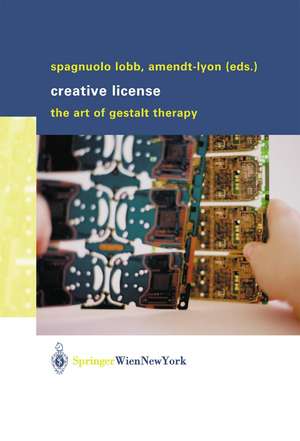Creative License: The Art of Gestalt Therapy
Editat de Margherita Spagnuolo Lobb, Nancy Amendt-Lyonen Limba Engleză Paperback – 6 noi 2012
| Toate formatele și edițiile | Preț | Express |
|---|---|---|
| Paperback (1) | 1159.55 lei 43-57 zile | |
| SPRINGER VIENNA – 6 noi 2012 | 1159.55 lei 43-57 zile | |
| Hardback (1) | 1170.32 lei 43-57 zile | |
| SPRINGER VIENNA – sep 2003 | 1170.32 lei 43-57 zile |
Preț: 1159.55 lei
Preț vechi: 1220.57 lei
-5% Nou
Puncte Express: 1739
Preț estimativ în valută:
221.87€ • 232.28$ • 183.59£
221.87€ • 232.28$ • 183.59£
Carte tipărită la comandă
Livrare economică 07-21 aprilie
Preluare comenzi: 021 569.72.76
Specificații
ISBN-13: 9783709173022
ISBN-10: 3709173027
Pagini: 312
Ilustrații: XV, 312 p.
Dimensiuni: 155 x 235 x 22 mm
Greutate: 0.47 kg
Ediția:Softcover reprint of the original 1st ed. 2003
Editura: SPRINGER VIENNA
Colecția Springer
Locul publicării:Vienna, Austria
ISBN-10: 3709173027
Pagini: 312
Ilustrații: XV, 312 p.
Dimensiuni: 155 x 235 x 22 mm
Greutate: 0.47 kg
Ediția:Softcover reprint of the original 1st ed. 2003
Editura: SPRINGER VIENNA
Colecția Springer
Locul publicării:Vienna, Austria
Public țintă
ResearchCuprins
Authors’ Addresses.- I The Emergency of the Creative Field.- 1. Toward a Gestalt Therapeutic Concept for Promoting Creative Process.- 2. On the Other Side of the Moon: The Import of Implicit Knowledge for Gestalt Therapy.- 3. Therapeutic Meeting as Improvisational Co-Creation.- 4. Creative Abilities and the Art of Living Well.- 5. “Tiger! Tiger! Burning Bright” - Aesthetic Values as Clinical Values in Gestalt Therapy.- 6. The Neuroscience of Creativity: A Gestalt Perspective.- II The Challenge of Defining Creative Concepts.- 1. Therapy as an Aesthetic Issue: Creativity, Dreams, and Art in Gestalt Therapy.- 2. Creativity as Gestalt Therapy.- 3. The Weighty World of Nothingness: Salomo Friedlaender’s “Creative Indifference”.- 4. The Influence of Otto Rank’s Concept of Creative Will on Gestalt Therapy.- 5. Beauty and Creativity in Human Relationships.- 6. The Aesthetics of Commitment: What Gestalt Therapists Can Learn From Cezanne and Miles Davis.- 7. Contact and Creativity: The Gestalt Cycle in Context.- III Connecting Theory and Practice: Case Examples.- 1. Embodying Creativity, Developing Experience: The Therapy Process and Its Developmental Foundation.- 2. One Therapy Session: Dialogue and Co-Creation in Child Therapy.- 3. Memorable Moments in the Therapeutic Relationship.- IV A Taste of the Field in Practice.- 1. Creativity in Long-Term Intimate Relationships.- 2. Creativity in Family Therapy.- 3. Creative Processes in Gestalt Group Therapy.- 4. Creative Adjustment in Madness: A Gestalt Therapy Model for Seriously Disturbed Patients.- 5. The Psychoportrait: A Technique for Working Creatively in Psychiatric Institutions.- 6. Blocks to Creativity in Organizations.- Biographical Notes.
Caracteristici
Comprehensive theoretical background for the concepts of art, creativity and aesthetics within the therapeutic relationship Theoretical guidelines for the creative professional practice of gestalt therapy Enables practitioners to tap into the rich resources of theory








